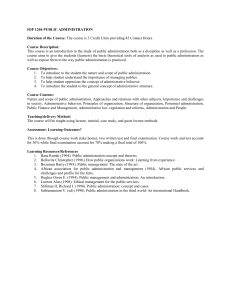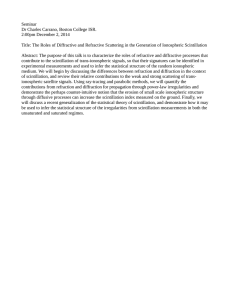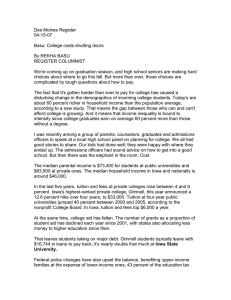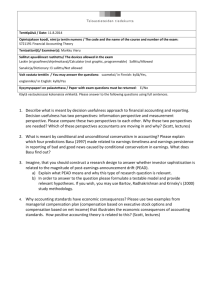A Couple’s Journey through Fifty Year’s of Ionospheric Space Weather Research
advertisement
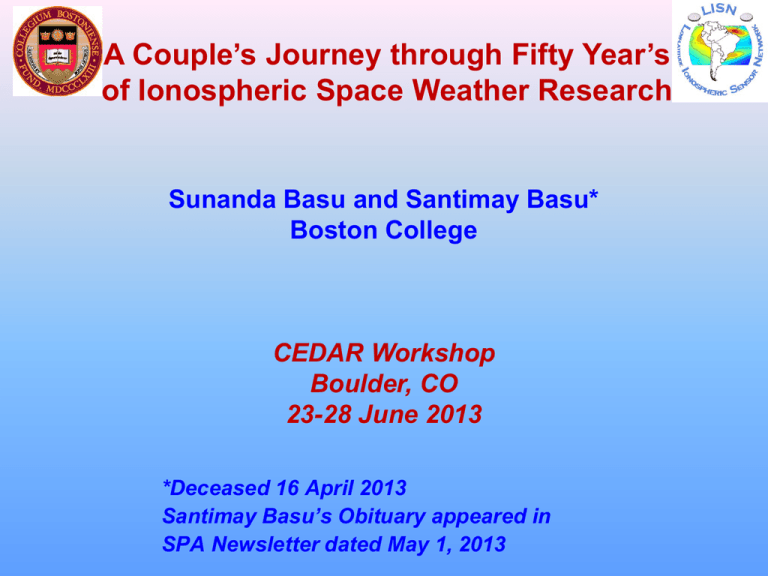
A Couple’s Journey through Fifty Year’s of Ionospheric Space Weather Research Sunanda Basu and Santimay Basu* Boston College CEDAR Workshop Boulder, CO 23-28 June 2013 *Deceased 16 April 2013 Santimay Basu’s Obituary appeared in SPA Newsletter dated May 1, 2013 Scope of Presentation • Sunanda’s Grad Student Years – Master’s in US – awesome discovery! Boston Globe Photo June 1963 – Ph.D. in India (a son born in between) • Santi’s Beacon Receiver Building Phase – In India with his grad students • • • • Sunanda’s Exciting NRC Post-doc Research Sunanda and Santi Partnership Phase 1 Sunanda’s NSF Decade – AER/CEDAR Sunanda and Santi Partnership Phase 2 Study of High Latitude Scintillations by Receiving Signals from Artificial Satellites One of the first studies of high latitude scintillations using satellites was made at Boston, MA in the early sixties by Jules Aarons and his group. The Soviet satellite Cosmos 1 and American satellite Transit 4A were used. Dependence of irregularities on signal frequency, latitude and magnetic activity were determined. Sagamore Hill, MA Sunanda Basu, MS Thesis, Boston Univ., 1963 Advisor: Gerald Hawkins Su. Basu et al., JATP, 1964; Aarons, Mullen and Basu, JGR, 1963;1964. Vertical profile of the ionosphere Incident Plane Wave TEC = 30 x 1016 m -2 Irregular Layer Emerging Wavefront Observer’s Plane Pictorial illustration of the phase fluctuations imposed on a wave-front traveling away from an irregular layer for a vertical radio path. For Scintillation Theory, see CEDAR Tutorial 2003 by Santimay Basu What are the major impacts of scintillation? Advantage of scintillation technique is in simplicity of the receiving system that can be used when the source is a satellite (high signal strength). Thus suitable also for developing countries (awesome discovery!) • Regional UHF Communication outages for extended periods (hours) • Increased Global Positioning Satellite (GPS) navigation errors • Degraded High Frequency (HF) radio communication Obstacles on the path to Sunanda’s Ph.D. • Expectation was that I would teach under-graduate Physics at a college for women – no opportunity to combine with research • Research in Radio Physics only possible at Calcutta University where Santi was on the faculty • Head of the Dept. there said he wouldn’t admit a woman • I was equally adamant that I would do research ( we decided to have a baby while waiting for an opening!!) • Six months after the birth of our son, we found another University in Calcutta called Jadavpur where the Head of Telecommunication Engg. was more open minded • I started work there with a junior fellowship from the UGC in June 1965 – a group of one with the expectation that Santi would provide guidance – and I haven’t stopped doing research since! Satellite signals received at Jadavpur & Haringhata 20 Mc/s BEC Su. Basu, JGR, 1967 40 Mc/s Basu & Das Gupta, JGR, 1967 Latitude Variation of TEC Basu & Das Gupta, JGR, 1967 Magneto-ionic Mode Coupling Su. Basu & S. Basu, JGR, 1969 Summary of Scientific Studies in Space Weather at Calcutta during 1965-1975 •Calcutta is located under the Northern Crest of the Equatorial Anomaly •Total Electron Content variation with satellites BE-B and BE-C measured at Haringhata could map the equatorial anomaly and its variations with magnetic activity •Magneto-ionic mode coupling and studies on refraction correction in the low latitude ionosphere were also performed at Jadavpur University ( Some Publications: Su. Basu, JGR, 1967; S. Basu and DasGupta, JGR, 1967, 1968, 1969; Su. Basu and S. Basu, JGR, 1969, 1971, 1972; DasGupta and S. Basu, Ann. Geophys, 1973) Dr. Jules Aarons with Prof. M. K. DasGupta, S. Basu and former students, A. DasGupta, S. Mitra and B.K. Guhathakurta at the Field Station in February, 1969. Susanto Basu, our son the future economics prof at age 4, not too thrilled to be in the company of grazing sheep in the Calcutta Maidan! Photo taken by Jules Aarons during his 1969 Calcutta visit Third International Symposium on Equatorial Aeronomy, Ahmedabad, India, 1969 Chapman 1888-1970 Su. Basu Sarabhai 19191971 Scope of Presentation Sunanda’s Grad Student Years – Master’s in US – awesome discovery! – Ph.D. in India (a son born in between) Santi’s Beacon Receiver Building Phase – In India with his grad students • • • • Sunanda’s Exciting NRC Post-doc Research Sunanda and Santi Partnership Phase 1 Sunanda’s NSF Decade – AER/CEDAR Sunanda and Santi Partnership Phase 2 Model of Equatorial Scintillation From Satellite In-Situ Measurements • The OGO-6 Retarding Potential Analyzer (RPA) data were made available to us in Calcutta by Prof. W.B. Hanson in 1974 (30 lb. data) • The in-situ measurements of Fregion irregularity amplitude and ambient electron density made by the RPA on OGO-6 near the perigee altitude of 400 km was utilized to determine the electron density deviation over the equatorial region. • A model of equatorial scintillation was developed in the framework of diffraction theory and 3-D irregularity power law index 4. • The occurrence contours of 140 MHz scintillations during 19 – 23 MLT for Nov-Dec period were derived. A pronounced longitude variation of the scintillation belt width and the occurrence was obtained in agreement with observations. (Su. Basu et al., Radio Sci., 1976) This was our first exposure to in-situ data and was followed by work with AE-D, AE-E and DE-2 all made available to us by Bill Hanson. Scintillatiions are most sensitive to density irregularities of sizes of Fresnel dimension L f ~ 1 km at VHF. Here outer scale Lo ~ 20 km, distance traveled by satellite in 3 sec, over which dN/N computed by OGO-6. Thus spectral shape has to be assumed to compute PSD at L f . A 3-D power law irregularity power spectrum with spectral index p = 4 used to compute scintillation (Rufenach, Radio Sci., 1975). Scope of Presentation Sunanda’s Grad Student Years – Master’s in US – awesome discovery! – Ph.D. in India (a son in between) Santi’s Beacon Receiver Building Phase – In India with his grad students Sunanda’s Exciting NRC Post-doc Research • Sunanda and Santi Partnership Phase 1 • Sunanda’s NSF Decade – AER/CEDAR • Sunanda and Santi Partnership Phase 2 Coordinated Jicamarca Radar and Scintillation Measurements at the Magnetic Equator In 1977, we performed for the first time co-ordinated 50 MHz radar and 137 MHz scintillation through a common ionospheric volume at the magnetic equator. It established that at the onset of spread-F, 3-m (50 MHz radar) and km-scale (137 MHz scintillation) irregularities attain saturation amplitude simultaneously. Later in the evening meter scale irregularities decay faster than kmscales owing to scale-length dependent cross-field diffusion coefficients. This confirmed Gerhard Haerendel’s theory of equatorial spread F (unpublished manuscript, 1974) that mother and daughter irregularities attain maturity at the same time because the growth rate of smaller irregularities is faster. (Basu et al., JGR, 1978) Observing Sites in the Equatorial Region used by AFRL to Determine Ionospheric Constraints on Communication and Navigation Systems Ascension Island in the South Atlantic has one of the most strongly turbulent ionospheres. Since the midseventies AFRL has used this ground station as the test bed for studying the robustness of communication and navigation systems. The multi-frequency scintillation input allowed the development of user-oriented scintillation models A First Day cover showing the tiny size of Asc. Is. Jicamarca radar, in Peru, at the magnetic equator allows us to study the initiation of equatorial plasma turbulence. Campaigns were conducted starting in the mid-seventies to understand F-region dynamics The fully steerable Altair radar has been used by AFRL starting in the eighties to study the physics of ionospheric turbulence and assess their impact on space surveillance. ALTAIR Radar 46m dish at VHF/UHF Jicamarca Radar at 49.9 MHz uses 18,432 dipoles Quiet-time Space Weather: Intense Scintillation Event at Ascension Island The AFSATCOM system provides Critical Satellite Communications support to the civilian community and military . “We are learning that space weather can have a significant effect on our communications…..We must provide either reliable communications or at least a forecast of when there will be disruptions……” Under solar maximum conditions, 20 decibel signal fadings at 1.5 GHz (GPS frequency band) and 6 decibel fadings at 4 GHz are routinely encountered at places like Ascension Island. Voice communication becomes choppy, and GPS position errors become unacceptable. Chief, AFSATCOM Systems Division (Basu et al., IEEE, SAC-5, 1987) Polar Cap VHF Scintillation Variation with Solar Cycle (Basu et al., Radio Sci., 1988) Polar Cap Patches PATCH STRUCTURING Model plasma transport By induced IMF variation UT and seasonal effects - Model reproduces observed effects Gradient drift structuring causes observed scintillation DAYSIDE PLASMA POLAR CAP MODEL NmF2 (Basu et al., GRL, 1995) OBSERVED UHF SCINTILLATION OBSERVED NmF2 Experiments in the Dark Cusp Ny Alesund, at the dayside cusp, is the entry point of polar cap patches and the seat of intense scintillation. We went on a 2-week campaign, obtained good data and left the instruments there. AFRL continues to perform round-the-clock scintillation and optical observations throughout the polar region in winter (Basu, et al., Radio Sci., 1994) It is also Polar Bear country, particularly In winter, when we make our observations. We were asked to carry a gun when going off the base! Global Satcom Outage Regions POLAR CAP PATCHES AURORAL IRREGULARITIES SATCOM GPS PLASMA DEPLETIONS EQUATORIAL F LAYER ANOMALIES GEOSAT WEATHER MAGNETIC Day EQUATOR Night GEOSATCOM Global Morphology of Scintillations (Basu et al., Radio Sci., 1988) Controlled Excitation of Plasma Processes in the Middle Latitude Ionosphere by High Power HF Radio Waves In March 1980, we used the Platteville High Power (1.5 MW) High Frequency facility and detected satellite scintillations from ground stations in Wyoming and from aircraft for underdense and overdense heating in connection with the then proposed Solar Power Satellite. In September 1981, we used the Arecibo heating facility at Islote and detected radio star scintillations at 430 MHz, Plasma Line enhancement and 50 MHz radar backscatter from Guadeloupe over the heated volume. In March 1984 and October 1992 we used the EISCAT, Norway, HF transmitters with ERP of 250 MW and studied the evolution of scintillations and irregularity structures from Tromso, Sjorkjosen, and Grunnfjord, Norway. (Publications: Basu et al., GRL, 1980, Basu et al., JGR, 1983, 1987, 1997; Costa, Basu et al., Radio Sci., 1997) Ionospheric Modfication Experiment at Grunnfjord, Norway with EISCAT Heater (Basu et al., JGR, 1997) S. Basu and R. Livingston at an improvised Field Site at a small fishing village! Desert Storm and AFRL (PL) Support to the Mission Prior to 1990, the Air Force was focused on communication and radar observations in the polar and auroral regions. During the Desert Shield phase before the Desert Storm Operation, we alerted the Strategic Air Command that Equatorial Scintillations will impact theater communication. We provided information on the time of occurrence of scintillation and the extent of their effect on VHF, UHF, L-band and S-band communication. This information helped the Air Force to efficiently prioritize the satellite communication links during scintillation events. Scope of Presentation Sunanda’s Grad Student Years – Master’s in US – awesome discovery! – Ph.D. in India (a son in between) Santi’s Beacon Receiver Building Phase – In India with his grad students Sunanda’s Exciting NRC Post-doc Research Sunanda and Santi Partnership Phase 1 • Sunanda’s NSF Decade – AER/CEDAR • Sunanda and Santi Partnership Phase 2 What led to Sunanda considering a position at NSF? • Membership in Advisory Committee for Atmospheric Sciences, 1988-1992 • Leading the CEDAR/High Latitude Plasma Structure Group Workshops for many years • Organizing the HLPS/GAPS Peaceful Valley Workshop in Lyons, CO in June 1992 • Challenge of becoming the first woman to direct the Aeronomy Program • Sunanda was Aeronomy Program Dir. 1992-2002 • As luck would have it Bob Robinson and I joined together! Gerhard Haerendel, Director, Max Planck Institute in Garching, Germany, Santi and Michael Mendillo at the ISEA-9 Meeting in Bali Indonesia, 1995. (I could not attend because of major surgery) Don Farley and me at the URSI General Assembly in Lille, France in 1996. As USNC/URSI Chair of Commission G, I nominated Don for the Appleton Prize which he won and I wrote an article on this in the CEDAR Post Scientific Initiatives at NSF AER/CEDAR Programs (1992-2002) • • • • • • Comet SL 9-Jupiter-NSF AER/AST/NASA, 1996 Ionospheric Interaction - NSF/ONR/AFOSR, 1997 CEDAR-TIMED - NSF/NASA(prior to launch), 1998 Maui-MALT – NSF/AFOSR(Haleakala site), 2000 CEDAR-GEM – NSF (M/I Coupling) Space Weather –NSF/NASA/DOC/DOD/FAA Immediately after leaving NSF, Chaired SCOSTEP CAWSES Program 2002-2005 – Presented the IAGA Association and URSI General Lectures in Toulouse, France and New Delhi, India respectively both in 2005 Germany, India and Japan had national CAWSES Programs Around the World for CAWSES (In 15 days in June 2004) 38,365 kilometers traveled! SCINTILLATION NETWORK DECISION AID (SCINDA) • Ground-based sensor network A REGIONAL NOWCASTING SYSTEM – Passive UHF / L-band /GPS scintillation receivers – Measures scintillation intensity and eastward drift velocity – Automated real-time data retrieval via internet • Data drives equatorial scintillation model providing simplified visualizations for UHF SATCOM users • Model produces tailored products distributed on Air Force Weather Agency web site Groves, Basu et al., Radio Sci. 1997 SCINDA Ground Stations Present and anticipated thru 2008 30N 0 30S 210E 240E 270E Existing Sites 300E 330E 0 UN IHY Sites 30E 60E 90E 120E 150E Other/collaboration Sensor network provides regional and global context for ionospheric disturbances Groves, 2008 C/NOFS: Communication Navigation Outage Forecasting System Santi and Ed Weber (deceased 2000) gave numerous briefings to the Air Force Space Command on C/NOFS Mission Concept • 400 km x 850 km; 13° Orbital inclination • Original launch date ~2003; Actual launch on April 16, 2008 • C/NOFS will Specify and Forecast Equatorial Scintillations from Satellite Insitu Measurements of - Electron Density, - Ion Density, - Ion Drift - Electric Field, - Neutral Wind - GPS Occultation Sensor - Tri-Band Radio Beacon Physics-Based Data Assimilative C/NOFS is a joint STP/AFRL, NRL, Model will Specify and Forecast NASA Program Ionospheric Scintillation Scope of Presentation Sunanda’s Grad Student Years – Master’s in US – awesome discovery! – Ph.D. in India (a son in between) Santi’s Beacon Receiver Building Phase – In India with his grad students Sunanda’s Exciting NRC Post-doc Research Sunanda and Santi Partnership Phase 1 Sunanda’s NSF Decade – AER/CEDAR • Sunanda and Santi Partnership Phase 2 Solar Storms Disturb the Magnetosphere, Ionosphere and Thermosphere … and interrupt civilian and military operations During the main phase of large magnetic storms an eastward electric field penetrates from high latitudes through midlatitudes to the equator over the dayside to the evening period. At normally benign mid-latitudes, storm enhanced density, associated with steep density gradients and electron density irregularities, is encountered in the early afternoon period. WAAS system providing guidance to aircraft is disabled owing to increased GPS navigation errors. If the penetration occurs in the evening hours, large plasma flows introduce strong phase scintillations and outages in GPS receivers. NASA Simulation At the magnetic equator, the eastward electric field at dusk causes deep plasma bubbles & severe scintillations, First Study of the Ionospheric Impacts of the Bastille Day Storm (Basu et al., GRL, 2001) As a consequence of the PPE, the F-region rises above DMSP. Point A denotes location of scintillation station at Ascension Island Rishbeth Meeting Sept 2010 38 The rapid time rate of change of Dst is associated with PPE, raising F-layer, generating bubbles & scint. Equatorial Ionosphere Severely Impacted During Halloween Storms in October 2003 During the Halloween Day storm of October 30, 2003, ground stations encountered intense TEC gradients and ionosondes observed spectacular height rise in the Brazilian sector Spectacular Height Rise of F-region 09 1000 11 30 OCTOBER 2003 13 15 17 19 21 23 31 OCTOBER 2003 01 03 05 07 09 LT 10 12 PAL HEIGHT (km) 850 700 550 8 MHz 7 MHz 6 MHz 5 MHz 4 MHz 3 MHz 400 250 100 SJC HEIGHT (km) 850 700 550 400 250 100 12 14 16 18 20 22 0 2 4 6 8 UNIVERSAL TIME (Basu et al., JGR, 2007) WAAS – A GPS-based Navigation System •It is used for navigation and precision approach to airports in US & parts of Canada & Mexico •WAAS is based on ~30 GPS reference stations •These stations are linked to form WAAS network •Each precisely surveyed station receives GPS signals and determines if any errors exist and relays the data to a Master Station •Master station computes correction information •Master station prepares correction algorithm & uplinks to a GEO satellite •GEO satellite broadcasts message on GPS L1 to receivers on aircraft flying within WAAS area •WAAS improves basic GPS accuracy to ~7m vertically and horizontally Three Superstorms Considered: Oct 29-31, 2003; Nov 20, 2003 and Nov 8, 2004 WAAS was unavailable within CONUS for more than 10 hours on each of the above dates WAAS Minimum Requirement for LPV is Availability > 95% of time over 75% of CONUS (Basu et al.,RadioSc.2010) TEC & GPS Phase Fluctuation Maps within CONUS during the Nov 8, 2004 Magnetic Storm GPS Outage Region BLO Intense GPS Phase Fluctuations (Delta TEC/MIN ) Occur Primarily in the Auroral Region at ~ 0100 UT. GPS outage caused WAAS to be non-operational for approximately 12 hours (Su. Basu et al., GRL, 2005) Impact of High Storm-time Ionospheric Velocities on the WAAS System GIVE Values Green < 6 m 6<Yellow<45 m Red > 45 m 6.13 TEC U = 1m delay (Su. Basu et al., JGR, 2008) Scope of Presentation Sunanda’s Grad Student Years – Master’s in US – awesome discovery! – Ph.D. in India (a son in between) Santi’s Beacon Receiver Building Phase – In India with his grad students Sunanda’s Exciting NRC Post-doc Research Sunanda and Santi Partnership Phase 1 Sunanda’s NSF Decade – AER/CEDAR Sunanda and Santi Partnership Phase 2 Lessons Learned • Have no regrets – do the right thing by your family at the cost of career • Follow your passion in the choice of your career • Not everyone gets things handed on a platter – working through challenges strengthens your character. The guidance of mentors is essential • High personal ethics is incredibly important • Volunteerism is the backbone of our community • Our science is so critically important to the environment around us that we have a special role to play in working on policy issues affecting it
